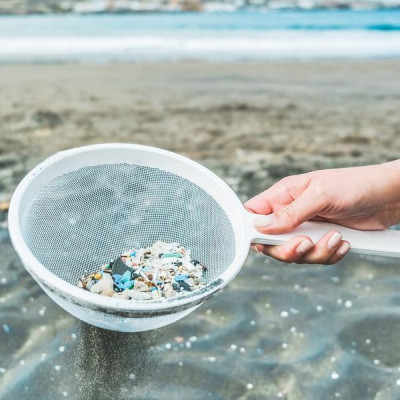
2021-09-20
Visited : 1335
The abundance of microplastic pollution from household waste has become a growing concern for the environment. These ubiquitous pollutants, found in rivers, lakes, and oceans, affect marine and human health alike. Additionally, with the increased use of cosmetics utilizing ingredients like microbeads, which are difficult to remove through water treatments, the need for a novel method to remove microplastic waste from water is paramount.
Carbon nanotubes have been considered for the removal of microplastic pollutants by various researchers through different strategies. This article will provide an overview of this revolutionary concept and the global impact of microplastic pollution.
What is the Environmental Impact of Microplastics?
Microplastics are characterized as a category of plastics that are less than 5 mm in diameter - it is this minuscule size that makes them difficult to remove. Rampant plastic pollution is still a concern worldwide as microplastics make up more than 94 percent of the Great Pacific Garbage Patch. Presence in such areas as well as their lack of degradation and purification within water plants, is a cause for great concern, especially considering the unknown effects of microplastics in drinking water. The severity of plastic pollution has led to research that is focused on these topics.
Microplastic Removal Research
In 2019, a group of pioneering researchers from the University of Adelaide investigated a novel technique that utilized spring-shaped carbon nanotubes to break down microplastic molecules. The approach aimed to purify plastic contamination within sewage. Researchers were hopeful about using an oxidant, polymonosulfate, to produce free radicals to attack and break down plastic into end products such as water and carbon dioxide.
Polymonosulfate is a persulfate salt that generates sulfate and hydroxyl radicals. To break down microplastics, the researchers aimed to activate this salt using carbon nanotubes coiled in a spring-like shape. These carbon nanotubes were designed in a helical shape with nitrogen dopants and encapsulated manganese carbide nanoparticles.
The Australian research team experimented with polyethylene pieces and successfully degraded them within a laboratory setting after just a few hours of treatment. However, one obstacle of the research was finding a way to reduce manufacturing costs for large-scale production of the carbon catalysts used in the treatment process.
Other researchers within Swansea University, UK, have also undertaken microplastic breakdown research, with their most effective techniques requiring 8 hours of treatment at 160 oC, though this temperature would not be feasible within actual wastewater treatments. Follow-up research has investigated removal technologies with less processing time and energy consumption.
Recent Innovations
A recent study led by Ye Tang, from the Shanghai Engineering Research Center of Biotransformation of Organic Solid Waste, East China Normal University, Shanghai, has undertaken research which consisted of synthesizing magnetic carbon nanotubes (M-CNTs) as adsorbates to remove microplastics. This research was published in the journal Chemical Engineering Journal on February 15th, 2021.
The research team experimented with M-CNTs, which were effectively adsorbed on polyethylene, polyethylene terephthalate, and polyamide. Using magnetic force, the microplastic-M-CNT composites were efficiently separated from aqueous solutions. The success rate consisted of removing 5 grams of microplastics per liter within 300 minutes and completely removing these pollutants from wastewater discharged from a kitchen waste treatment plant.
In terms of environmental impact, adsorbed M-CNTs can be recycled through thermal treatment at 600 oC, indicating a promising future for the breakdown of microplastics.
Significance of Microplastic Breakdown
There are approximately 12 million tons of plastics that are released into our waters annually. With their current production rate and the lack of appropriate disposal, there is an estimate that by 2050, the number of plastics within the ocean will outweigh that of fish.
The ability of microplastics to adsorb organic pollutants, heavy metals, and pathogens, along with anti-corrosive characteristics, can be a threat to marine life due to being preserved in waters for an extended period. Furthermore, the food chain can be affected due to the spread of pathogens and other deadly threats, which ultimately can affect human life through the consumption of fish or even drinking water.
The control of microplastic pollution is crucial for all industries, especially those involved in creating plastics, who would have more responsibility for developing more sustainable disposal processes.
Challenges
Single-use disposable applications like packing, which makes up 50% of plastic use, require adaptive solutions; replacing the plastic entirely or creating a more sustainable alternative are possible options. The use of microplastics within cosmetics should also be a focal point. With more awareness of their negative ramifications, companies are more likely to fulfill their sustainable duty to customers.
With recycling being a waste-management strategy as well as reducing the burden of plastics on the environment, there may be an additional need for more re-manufacturing for materials to be remade into other long-term sustainable products.
Additionally, with a greener vision, more companies have started an initiative of taking back unwanted or end-of-life products for re-manufacture. These initiatives are beneficial to customers who would be able to trust the sustainability of their unwanted products and industry leaders that can create long-lasting brand loyalty in return.
Microplastic breakdown is a significant part of a more sustainable future. To effectively break down these anti-corrosive materials, green initiatives would have to be required by governmental bodies that direct how wastewater plants work. Using magnetic carbon nanotubes for this purpose may be an effective alternative to current purification methods, which hold no effect on microplastics. However, use within global wastewater plants would be a significant obstacle that would require overcoming.
Read the original article on AZoNano.